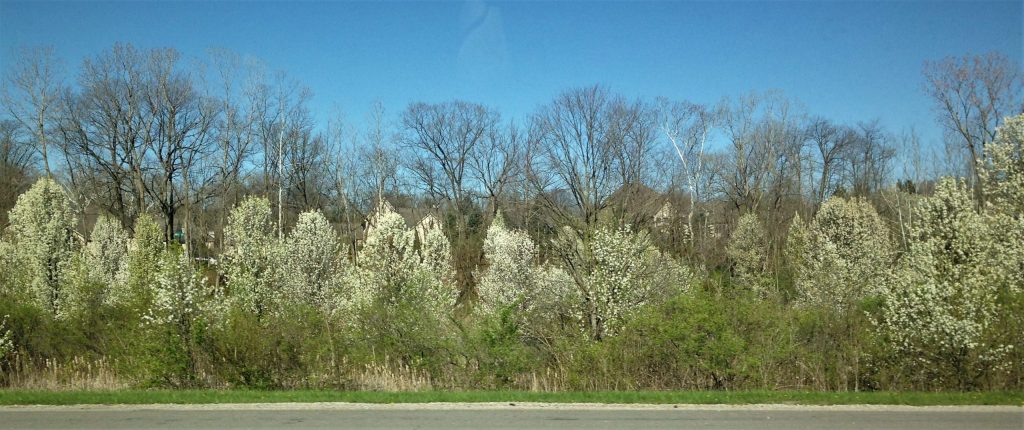Updates on Amendment to Terrestrial Invasive Plant Rule
We are asking the Department of Natural Resources move forward with an Amendment to the Indiana Terrestrial Invasive Plant Rule that went into effect in 2019.
The Amendment adds twelve highly invasive plant species to the rule, which bans their sale, distribution, and transport in Indiana (312 IAC 18-3-25). Invasive species listed in the Amendment are Callery pear, Norway maple, sweet autumn clematis, burning bush, moneywort, Chinese maiden grass, wild parsnip, Fine Line buckthorn, spreading hedge parsley, Japanese hedge parsley, lesser celandine, and European highbush cranberry.
Where We Are Now
The Department of Natural Resources–Division of Entomology and Plant Pathology proposed the Amendment in 2021. In 2023 the DNR decided that, to ensure rules are current and enforceable, all DNR rules must be re-codified. They further specified that during this recodification process no rules could be amended. The original Terrestrial Plant Rule may be re-codified in 2025, after which the Amendment could potentially proceed. However, the DNR may wait until all rules are codified, which means the Amendment could move forward as late as 2026 or 2027.
To reduce the economic and environmental impacts of invasive plant species in Indiana, we have initiated appeals to Governor Holcomb to prioritize this effort.
Call to Action
We are calling on your help to get the Amendment on a faster track. Here are two ways to further the cause:
- You can sign a petition to the Governor to help pass the Amendment. We’re aiming for 5,000 signatures and are just over 4,000 so far. Sign the petition
- You can enlist an organization to sign on to a letter to the Governor urging passage of the Amendment (reproduced below). A spreadsheet of those organizations is here. You can sign up to contact a specific organization, then update the list with any positive or negative response you receive. The goal is to get as many as possible to sign on by August 31. Download the letter
Letter to the Governor
The Honorable Eric Holcomb
Governor of Indiana
Dear Governor Holcomb,
The undersigned organizations are writing to respectfully request that the Department of Natural Resources move forward with the Terrestrial Plant Rule Amendment. This amendment adds twelve highly invasive plant species to the rule that bans their sale, distribution, and transport in Indiana (312 IAC 18-3-25). The full list of invasive species in the amendment is Callery pear, Norway maple, sweet autumn clematis, burning bush, moneywort, Chinese maiden grass, wild parsnip, Fine Line buckthorn, spreading hedge parsley, Japanese hedge parsley, lesser celandine, and European highbush cranberry.
Invasive plant species cost Indiana money. Indiana landowners and land managers spend more than $8.6 million dollars annually to combat invasive species on their land. This is assuredly an underestimate, as a full survey of landowners in Indiana has not been done. One federal property in Indiana is spending over $100,000 to manage just one of the twelve species, Callery pear, every year to keep it from taking over thousands of acres of forest.
Invasive plant species harm the environment.
- Invasive plants hurt wildlife by crowding out the plants our native animals need for food and cover.
- Most invasive shrubs and trees are little used by native insects. This reduces habitat for beneficial pollinators and predatory insects, as well as reducing the amount of food available for birds to feed their nestlings.
- Invasive plants destroy habitat for rare wildflowers and animals, threatening two-thirds of all endangered species.
- Invasive plants can become weedy in a home garden, crowding out landscaping plants.
- Invasive plants can also decrease enjoyment of hunting, fishing, mushroom collecting, bird-watching, and many other recreational pursuits by crowding forest floors and choking waterways, making use of these areas difficult.
- The delay in implementing this rule amendment has meant that thousands more invasive plants have been sold and planted in the state, further compounding the problem we face.
Most invasive plant species are introduced through landscaping and other plantings.
Over 86% of naturalized woody shrubs species have been deliberately introduced for landscaping, soil erosion control, or forestry purposes. Horticulture is the leading source of invasive plant species, and stopping their continued introduction through this rule amendment is crucial.
The original Terrestrial Plant Rule to ban 44 species was went into effect in 2020 [it was passed in 2019 but there was a one year delay in implementation], and the current amendment was drafted in 2021 to add twelve highly invasive species. Unfortunately, the DNR has not been able to move this rule amendment forward due to other priorities. We ask that you prioritize this effort to reduce the economic and environmental impact of invasive plant species in Indiana.
Respectfully yours,
[List of organizations]

